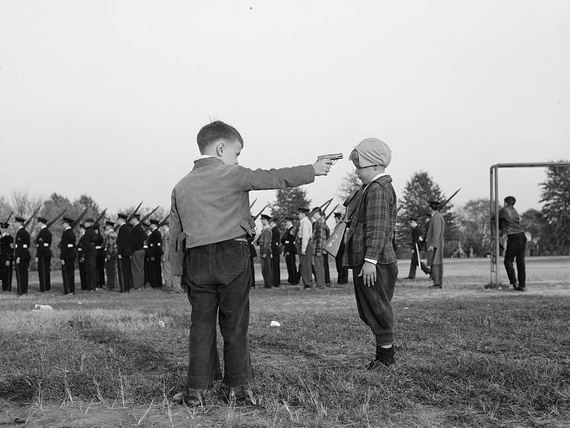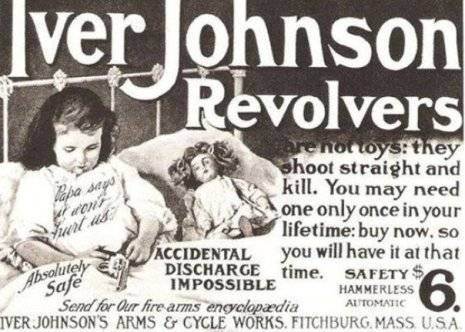Shocked by the horrific event in Charleston? That's America, baby -- Columbine, Aurora, Newtown -- its everyday stuff -- just the way life is in our country.
Each night children go to bed with "Bang, bang, you're dead . . . thirty bullets in your head," At school, they learn to give things their "best shot," and to meet "bang-up" expectations. When their efforts finally "go over with a bang," they attain recognition as a "top gun."
Shooting Their Mouths Off
"Top guns" were once synonymous with "great guns." Our first "great guns" were simply large firearms like cannons, as opposed to smaller ones such as muskets or rifles, a distinction which held up to the end of the 19th century. They also came to name a person of note or consequence. The man we used to call a "great gun" was really something. Today we know him better as the real "big shot."
Speaking of "big shots," no one "goes great guns," is more successful in pushing arms, than the manufacturers of guns and ammunition and their proxy, the N.R.A.
More Bang for the Buck
The expression, "going great guns" comes from British naval slang of the 18th century when "blowing great guns" signified a violent gale. For manufacturer of arms, however, it's less a threatening storm than a windfall of profits. Gun makers churned out nearly six million guns last year -- double the number that they did a decade ago. This year, the industry is expected to rack up in excess of $11.7 billion in sales and $993 million in profits.
They are literally getting "more bang for the buck."
In 1953, the U.S. Joint Chiefs of Staff came up with a 'New Look' policy promising more combat effectiveness for less money, by substituting atomic firepower for manpower and conventional weaponry. They described it as the 'bigger bang for your buck' theory, a variation on Pepsi-Cola's 'More Bounce to the Ounce' (c.1950).
Today, "more bang for the buck" speaks directly to those seeking great returns for an investment in arms. It's not just guns. It's ammunition as well. As one gun lobbyist once put it, "You make a product for $300, and somebody could buy this revolver and, by the time they are 80, they'll have fired $10,000 worth of ammunition through it."
Better perhaps we should rephrase investment in armaments as "More bucks for the bang."
Calling the Shots
Massacres are good business at creating "more bucks for the bang." Critics may dramatically depict the results and fill the airwaves with talk about the need for new restrictions, but they only serve to convince gun owners that government is going to take away their right to buy guns, further spurring sales.
Feeding that frenzy is their mantra that everyone should be armed. When tragedies involving guns occur, they even go so far as to blame victims or their protectors for not having been properly armed. Their answer to gun violence, you see, is simply more guns.
That's hardly a new idea. People have been keeping the peace with guns ever since 1330. The soldiers at Windsor Castle named their favorite and most prominent weapon -- a huge catapult which hurtled large stones and balls of fire at the enemy -- "Dame" or "Lady Gunhilda" from Icelandic gunnr, meaning "war" and hildr, a "battle". Later, with the advent of the cannon, it was first shortened to gunne and later to gun, thus naming the world's first firearms.
Though 75 percent of the American people favor some form of restriction on handguns, the big shots at the NRA work relentlessly towards its goal of a fully armed America. The sights of its 2.8 million members trained on Congress, it continues to "call the shots," setting the substance and pace of the national debate. Congress is their target and they are dead on in compliance. It hasn't passed a gun control measure since 1999.
The results are in. Today, you can find those sons of a gun everywhere. The horrors continue. And there's no leadership in Congress willing to act decisively in any organized fashion to curtail their proliferation.
A Farewell to Arms
Sooner or later, we'll just have to "bite the bullet" on the subject. A century ago, before anesthesia, it was common to give a wounded soldier a bullet to bite on in order to divert his attention from the pain of a battlefield amputation
No easy task to bite the bullet. In 1857, the Sepoys, many of whom were Muslim and Buddhist and constituted a large portion of Britain's crack regiment in India, refused to fight, the mutiny ultimately breaking out into a full scale rebellion. The cause of their discontent was their belief that the bullets they first had to bite prior to firing were wrapped in a protective coating of lard and beef wax. Fact or fiction, the rumor managed to offend at once both the Buddhists to whom the cow was sacred and the Muslims to whom the pig was taboo.
Like good soldiers, we too will have to grit our teeth and do what has to be done. As Rudyard Kipling once wrote, "Bite the bullet old man, and don't let them think you're afraid." ("The Light that Failed," 1891).
Follow Larry Paros @
insomanywords.net
Take words with Larry @
twitter.com/wordswithlarry
facebook.com/wordswithlarry
pinterest.com/wordswithlarry
More fun with words by Larry
bawdylanguage.com


